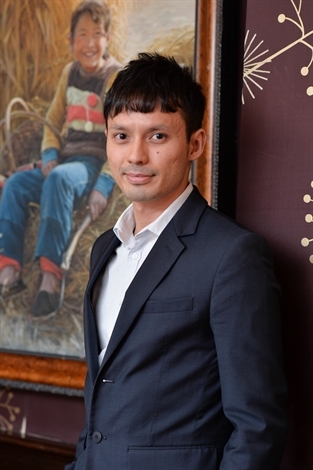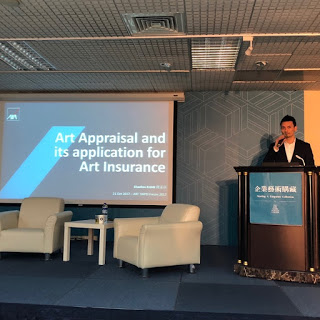An ISA Member in the Far East
Popular Tags

Friday, September 21, 2018 in Member Insights
I was the Chief Claims Adjuster and Risk Surveyor for AXA ART, the global art insurance specialist, in Asia, when I applied for ISA membership in 2016.
Art insurance is still a developing business in the region, where more collection owners or custodians elect to self-insure rather than taking up specialist coverage. I worked with a small team at AXA ART and was the only member with adequate art knowledge, therefore, I was tasked with the responsibility of verifying and approving the sum insured (on agreed value basis) of artworks proposed by brokers and clients on their insurance policies. People began to approach us with items which they thought were of high worth and wanted to insure, including items purchased many years ago or passed down to the family, and expected us to provide a solution or referral for valuation. These requests were particularly common when I was conducting risk surveys at clients’ homes. After a while, it became apparent that if I could add art appraisal expertise to my skill set, it would help to progress my career.
There are a very low number of professional art appraisers in Asia due to lack of demand. In Hong Kong, we have a low tax rate and a simple tax system that provides no tax relief for charitable donations, except for cash contributions. Additionally, estate duty has been abolished, so neither estate duty accounts nor clearance papers need to be filed. With no governmental requirements for appraisal, there is simply limited demand to support professional appraisal businesses. At the same time, China and Hong Kong have emerged dramatically as an art market and are now considered the world’s second largest, according to The Art Market 2018 report published by Art Basel and UBS. The lack of professional art appraisal service is hindering the growth of other financial services, such as art insurance and art-backed loans.
There is clearly enormous potential for appraisers in Asia, but what convinced me to obtain a formal education in art appraisal was my personal involvement in a unique damage claim.
 Hong Kong Harborfront© Art Basel
Hong Kong Harborfront© Art BaselAn auction house client reported a claim for damage to a Song dynasty ceramic vase that was on consignment to them. The damage was a hairline crack to the edge of the base. In these situations, restoration may not be the best option, as the market preference is to avoid alteration on minor damage. We agreed with the client and consignor to settle on a diminution of value basis. As there was no qualified appraiser available to take up the assignment, and because of an urgency to settle the claim, all parties agreed to a proposal of having two antique dealers inspect the damaged vase. Each dealer would separately suggest the percentage loss in value, then we would use the mean as the basis of settlement. In the end, both dealers came up with the exact same extreme percentage, which took everyone by surprise. They did not provide any reasoning or justification of their valuation, and were not obligated to. We had no option but to settle the claim accordingly. This experience motivated me to source an independent, transparent appraisal process for future claims in order to leave no party confused or suspicious. My research subsequently led me to ISA.
Attending ISA courses in Naperville turned out to be one of the best decisions I made for my career. First of all, it was achievable. I was able to start from scratch and complete the Core Course, the 15 Hour USPAP course and Fine Art course in three weeks. The courses were well structured, with visits to art museums and a printmaking studio. The classroom discussions were particularly lively and often based on real-life examples shared by fellow colleagues encountered in their daily businesses. Coming home with my new credential, I was determined to spread the word and do what was necessary to promote good appraisal practices with the goal of raising overall personal property appraisal standards in the region. Using knowledge I gained through my ISA education, I was able to educate industry professionals and art collectors. I informed bankers and insurance professionals on what USPAP is and asked them to consider USPAP-compliant reports only for their insurance policies or lending out loans. For art collectors, I promote periodic appraisal as part of a good collection management program, together with a robust inventory system, maintaining good documentation of provenance and purchase records, a secure display/storage environment, and adequate insurance coverage. My message is that an appraisal report is essential for accounting and estate planning purposes, or if one wishes to secure loans using their art collection as collateral.
 Lecture at Art Taipei Forum 2017
Lecture at Art Taipei Forum 2017My ISA education helped me a great deal in improving communication with our claimants. Although I would not perform appraisal on damage claims that I directly handle, I could use my knowledge to guide loss adjusters to look for the correct data and comparables, seek opinions from the right experts to determine the settlement offer amount, as well as make sure their communication with the client is clear and appropriate. I demand that the loss adjusters demonstrate clearly how they arrive at the settlement offer. There are always brokers or clients who are dissatisfied with the offers, yet there has never been any complaint on the communication or lack of transparency since. Also, we’ve seen a significant drop in claim disputes for my department and my company was able to highlight our claims service as a selling point for our insurance products. I’ve also noticed in places where there is no local law governing personal property appraisal, highlighting USPAP and the ISA Code of Ethics always provide confidence to clients in knowing that the appraisals are being conducted in a responsible manner.
I would advise fellow appraisers living outside of the USA to try to attend courses on site or attend the ISA annual conference, Assets. One can feel isolated sometimes due to having few peers in the market, and for our profession, it is important to build a network of experts of different backgrounds and knowledge. Attending ISA courses or the Annual Conference is a great way to tap into the vast experience of fellow appraisers, and from my experience, they are always happy to share.
- Khadinn Khann, ISA AM, is an appraiser based on Hong Kong and has been a member of ISA since 2016. Learn more about ISA membership.
